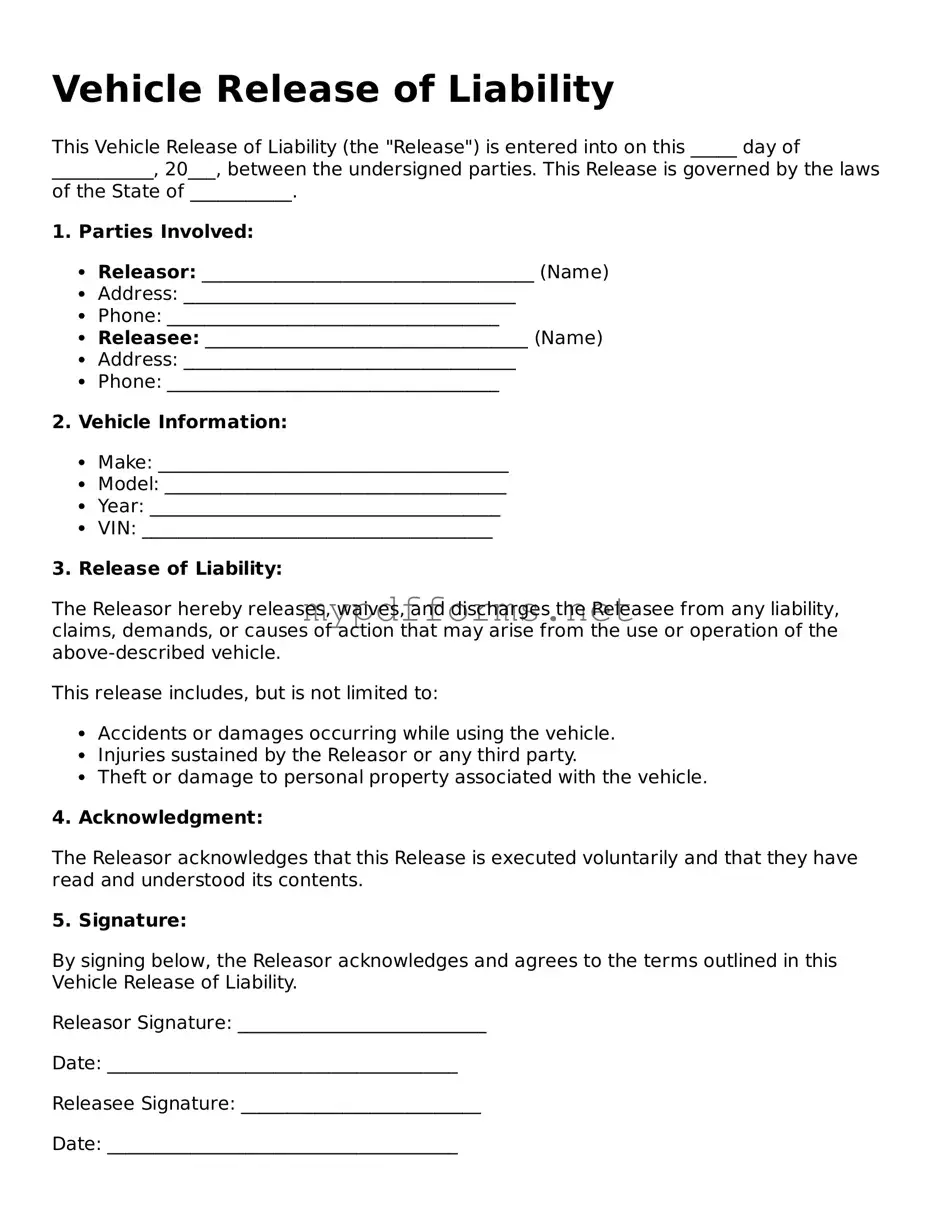The Vehicle Release of Liability form is akin to a waiver of liability, commonly used in various contexts. This document allows individuals to acknowledge the risks associated with an activity and agree not to hold the provider responsible for any injuries or damages. Just like the Vehicle Release of Liability, a waiver of liability is signed before engaging in activities such as extreme sports or recreational events, ensuring that participants understand the potential hazards involved.
Understanding the importance of a comprehensive Release of Liability form is essential for protecting your interests in various activities. This form helps clarify and limit potential legal exposure by ensuring all parties are aware of the associated risks and responsibilities involved.
Another similar document is the Hold Harmless Agreement. This form serves to protect one party from legal liability for any injuries or damages incurred by another party. In the context of vehicle use, this agreement can be utilized when lending a car to a friend or family member, ensuring that the lender is not held responsible for any accidents that may occur while the vehicle is in someone else's possession.
The Indemnity Agreement shares similarities with the Vehicle Release of Liability form, as it involves one party agreeing to compensate another for any losses or damages. This type of agreement is often used in business transactions, particularly when one party may face liability due to the actions of another. In a vehicle context, it can protect a vehicle owner from financial repercussions resulting from the actions of a driver using their car.
A Rental Car Agreement is also closely related. When renting a vehicle, the rental company typically requires the renter to sign a document that outlines the responsibilities of both parties. This agreement often includes clauses that release the rental company from liability for accidents or damages that occur while the vehicle is in the renter's possession, mirroring the intentions of a Vehicle Release of Liability form.
The Release of Claims form is another document that serves a similar purpose. This form allows individuals to relinquish their right to pursue legal action against another party for specific claims. In the case of vehicle use, a Release of Claims might be signed when a vehicle is sold, ensuring that the seller is not liable for any issues that arise after the sale is completed.
The Consent to Treat form, often used in medical settings, bears resemblance to the Vehicle Release of Liability form in that it allows individuals to acknowledge risks. By signing this document, patients agree to receive medical treatment while understanding the potential for complications. Similarly, a Vehicle Release of Liability form informs vehicle users about the risks associated with operating a vehicle and the potential for accidents.
The Trip Waiver is a document used by travel companies that allows participants to acknowledge the risks involved in a trip. By signing this waiver, travelers agree not to hold the company liable for any injuries or accidents that may occur during the trip. This mirrors the Vehicle Release of Liability form, as both documents aim to inform individuals about risks while limiting liability for the provider.
The Event Liability Waiver is another document that shares common ground with the Vehicle Release of Liability form. This waiver is often required for participants in events such as marathons or festivals. It ensures that participants understand the risks involved and agree not to hold the event organizers liable for any injuries sustained during the event, similar to how vehicle users acknowledge risks associated with driving.
Insurance Release forms also reflect the same principles found in the Vehicle Release of Liability. These forms are often used when individuals seek to waive their right to claim insurance benefits after an accident or incident. By signing, individuals agree to release the insurance company from any further obligations, much like how the Vehicle Release of Liability form limits the liability of the vehicle owner.
Finally, the Liability Disclaimer is a document that serves to inform individuals of the risks associated with a service or product. When using a service, such as a driving school or vehicle repair shop, clients may be required to sign a liability disclaimer that releases the provider from responsibility for any accidents or damages. This is closely aligned with the Vehicle Release of Liability form, as both documents aim to protect the provider from legal claims arising from the use of their services.
